Urban Outfitters Bundle
Can Urban Outfitters Maintain Its Edge in Today's Retail Arena?
Urban Outfitters, Inc. has carved a unique niche in the fashion and lifestyle market since its inception in 1970. From its roots as a counter-culture boutique, the company has evolved into a multi-brand powerhouse. This evolution underscores its ability to adapt to the ever-changing demands of the Urban Outfitters SWOT Analysis, showcasing its strategic agility.
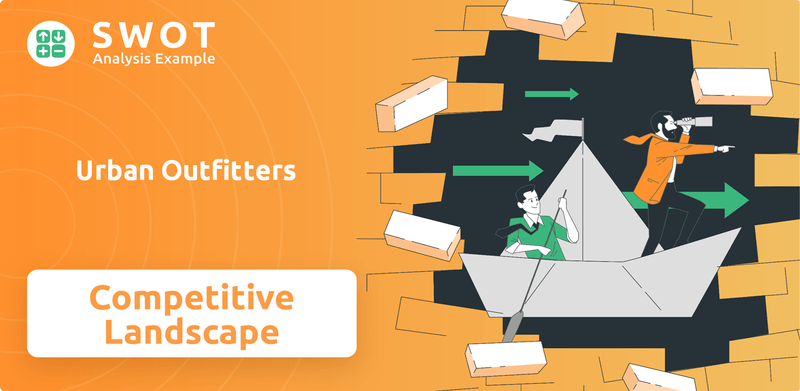
Understanding the Urban Outfitters competitive landscape is crucial for investors, analysts, and anyone interested in the fashion retail market. This analysis delves into Urban Outfitters competitors, examining their strategies, market positioning, and impact on the company's performance. We'll explore the Urban Outfitters market analysis to identify key rivals and the factors shaping its future.
Where Does Urban Outfitters’ Stand in the Current Market?
Urban Outfitters, Inc. carves out a distinct niche within the lifestyle retail industry, primarily targeting young adults and women aged 18-30 through its Urban Outfitters brand, while extending to a slightly older demographic with Anthropologie and Free People. The company's market position is consistently strong, ranking among the top specialty retailers in North America and Europe for its target demographics. This strategic focus allows for a curated brand experience that resonates with its core customer base, setting it apart from mass-market competitors.
The company's core operations revolve around designing, sourcing, and selling a diverse range of products, including apparel, accessories, home goods, and beauty items. A key element of its value proposition is its emphasis on trend-driven and unique assortments. This approach ensures that Urban Outfitters remains relevant and appealing to its target market. The company's business model is built on a combination of physical stores and robust digital channels, ensuring a broad reach and multiple touchpoints for customer engagement.
Urban Outfitters, Inc. reported total net sales of $5.25 billion in fiscal year 2024, demonstrating its significant scale within the industry. As of January 31, 2024, the company operated 262 Urban Outfitters stores, 237 Anthropologie Group stores (including Anthropologie and Terrain), and 199 Free People stores globally. The expansion of digital channels has been a strategic priority, with the digital segment showing continued growth in fiscal year 2024. The introduction of Nuuly, a clothing rental subscription service, illustrates the company's adaptability to changing consumer preferences and its commitment to the circular fashion economy.
Urban Outfitters maintains a strong market position, particularly in North America and Europe. While specific market share data for 2024-2025 is still under analysis, the company is a significant player in the specialty retail sector. Its brand positioning focuses on lifestyle and trend-driven products, appealing to a specific demographic.
The company's product range includes apparel, accessories, home goods, and beauty products. These offerings are curated to reflect current trends and unique styles. This diversified product selection helps attract and retain a broad customer base within its target demographic.
Urban Outfitters has a substantial presence across North America and Europe. The company operates numerous stores in these regions, alongside a growing digital presence. This strategic geographic distribution supports its overall market strategy and customer reach.
The company has invested heavily in its digital channels, which have shown significant growth. The launch of Nuuly, a clothing rental service, demonstrates a proactive approach to evolving consumer preferences for sustainability and access. This strategic move broadens its revenue streams.
Urban Outfitters' ability to adapt to market changes is a key factor in maintaining its competitive edge. The company's focus on digital channels and the introduction of Nuuly demonstrate its responsiveness to evolving consumer behaviors. This proactive approach allows it to capture new revenue streams and customer segments, which are key elements of the Marketing Strategy of Urban Outfitters.
- Continued growth in digital sales reflects the success of its digital transformation strategy.
- Nuuly's expansion into the circular fashion economy caters to consumer demand for sustainable options.
- These initiatives highlight the company's commitment to adapting to market shifts and capturing new opportunities.
Urban Outfitters SWOT Analysis
- Complete SWOT Breakdown
- Fully Customizable
- Editable in Excel & Word
- Professional Formatting
- Investor-Ready Format
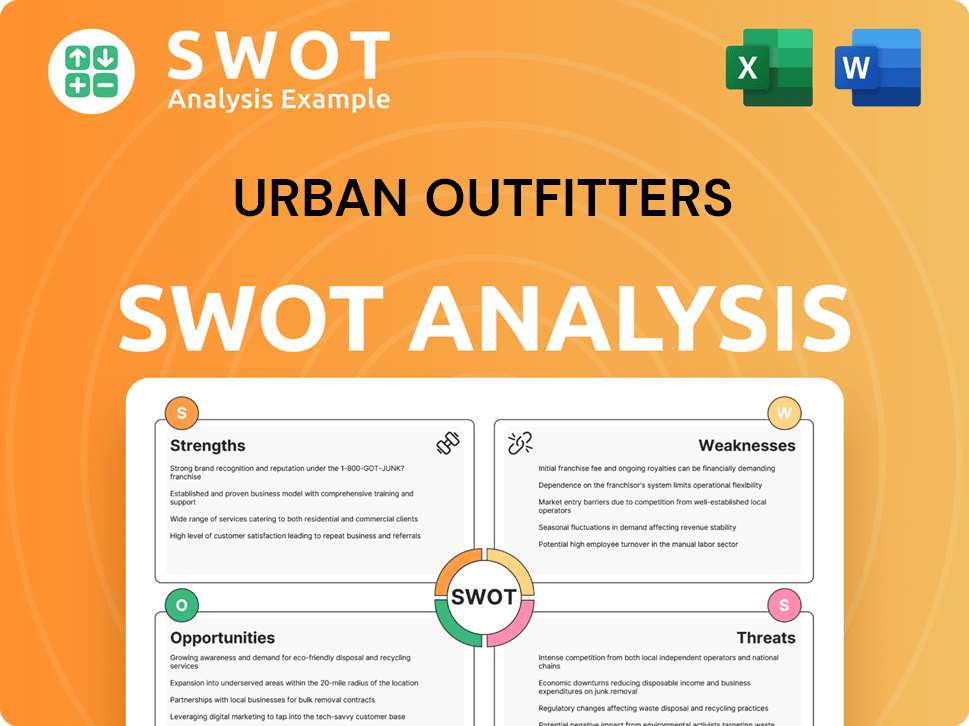
Who Are the Main Competitors Challenging Urban Outfitters?
The Urban Outfitters competitive landscape is multifaceted, encompassing a wide array of rivals across the fashion and lifestyle sectors. Understanding these competitors is crucial for assessing the company's market position and strategic challenges. This analysis considers both direct and indirect competitors, evaluating their impact on Urban Outfitters' business.
The retail competition is intense, with companies vying for market share through various strategies. These include pricing, trend adoption, and the expansion of both physical and online retail footprints. Examining the competitive environment allows for a comprehensive Urban Outfitters market analysis, highlighting key areas of strength and potential vulnerability.
Direct competitors of Urban Outfitters include specialty retailers that target similar demographics with apparel and accessories. These companies often compete on pricing, trend relevance, and store presence. Analyzing these rivals provides insights into the dynamics of the fashion retail market.
Abercrombie & Fitch Co., including Hollister Co., is a direct competitor. They focus on young adult demographics with trend-focused apparel. The company's strategies often involve aggressive pricing and extensive retail networks.
American Eagle Outfitters, including Aerie, also competes directly with Urban Outfitters. They target similar consumer groups with fashion-forward apparel and accessories. In fiscal year 2023, American Eagle Outfitters reported net revenue of approximately $5.3 billion, demonstrating their scale in the market.
Fast-fashion retailers like Zara (Inditex) and H&M are significant competitors due to their competitive pricing and rapid inventory turnover. These companies introduce new styles frequently, influencing market trends. Their business models present a challenge to Urban Outfitters' curated aesthetic.
Online-only retailers and direct-to-consumer (DTC) brands pose a growing threat. These companies often specialize in specific product niches or sustainable practices. Their agility and targeted marketing strategies allow them to capture market share.
ASOS and Revolve Group are examples of online retailers with strong digital presences. They cater to fashion-conscious consumers, competing with Urban Outfitters in the digital space. These companies focus on online sales competition.
Indirect competitors include those in the home goods and lifestyle product segments, as well as resale platforms. These competitors challenge Urban Outfitters through price, selection, and convenience, impacting the overall Urban Outfitters industry. Understanding these indirect rivals is crucial for a comprehensive market analysis.
- Mass Merchandisers: Retailers like Target and IKEA compete in the home goods segment.
- Specialized Boutiques: Home decor boutiques and online platforms like Wayfair and Etsy also pose competition.
- Resale Platforms: Depop and Poshmark offer alternative avenues for acquiring unique clothing, aligning with a segment of Urban Outfitters' customer base.
- Market Dynamics: Ongoing mergers and acquisitions in the retail sector shape the competitive landscape.
Urban Outfitters PESTLE Analysis
- Covers All 6 PESTLE Categories
- No Research Needed – Save Hours of Work
- Built by Experts, Trusted by Consultants
- Instant Download, Ready to Use
- 100% Editable, Fully Customizable
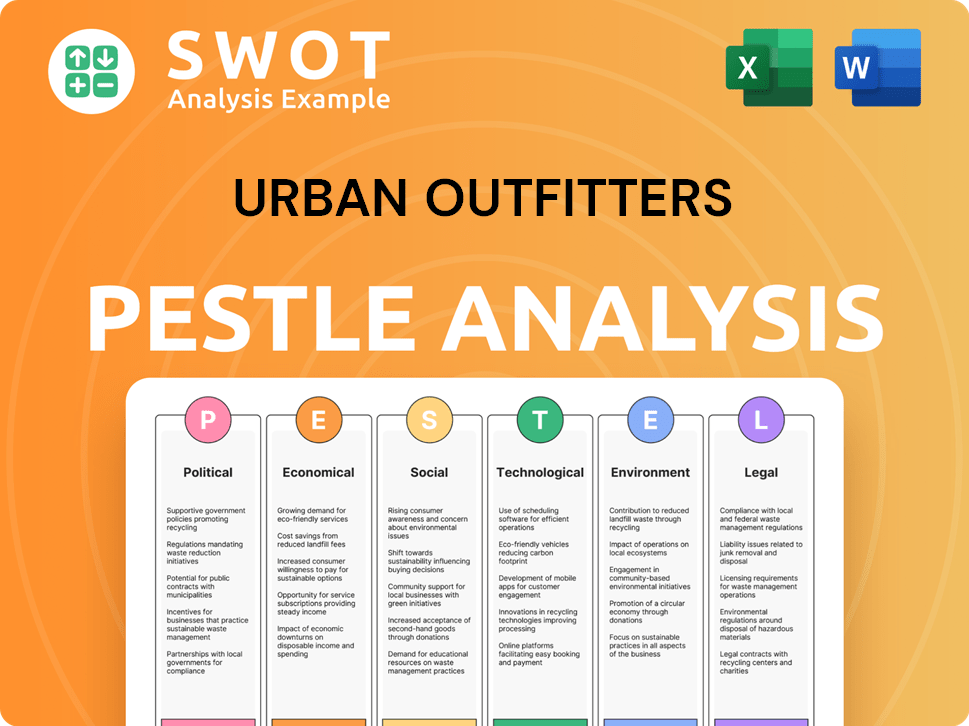
What Gives Urban Outfitters a Competitive Edge Over Its Rivals?
Understanding the competitive landscape of Urban Outfitters requires a deep dive into its strengths. The company has cultivated strong brand equity across its portfolio, including Urban Outfitters, Anthropologie, and Free People. This brand differentiation allows for premium pricing and fosters customer loyalty. A key element of their success is the ability to anticipate and capitalize on emerging fashion trends, often setting them rather than following.
Urban Outfitters' omnichannel retail strategy is another significant advantage. This approach integrates physical stores, e-commerce platforms, and catalog sales, providing a seamless shopping experience. Their physical stores are designed to be immersive and engaging, encouraging longer visits. Effective supply chain management and inventory strategies enable the company to respond quickly to consumer demands, minimizing markdowns and supporting healthy margins.
The clothing rental subscription service, Nuuly, represents a forward-thinking move, tapping into the growing circular economy. This innovation diversifies revenue streams and positions the company well in the evolving retail landscape. It is important to note that the retail industry is highly competitive, and continuous innovation is crucial to maintain these advantages. For a detailed look at their growth strategies, consider reading about the Growth Strategy of Urban Outfitters.
Urban Outfitters' diverse brand portfolio, including Urban Outfitters, Anthropologie, and Free People, caters to various customer segments. Each brand maintains a unique aesthetic, fostering strong customer loyalty. This differentiation allows the company to command premium pricing.
The company's integrated approach combines physical stores, e-commerce, and catalog sales for a cohesive shopping experience. Physical stores are designed to be immersive, enhancing customer engagement. This strategy provides multiple touchpoints for customers.
Urban Outfitters' ability to identify and capitalize on emerging trends is a key competitive advantage. The company often acts as a trendsetter, differentiating itself from competitors. The launch of Nuuly demonstrates a forward-thinking approach.
Effective supply chain management and inventory strategies enable the company to respond quickly to changing consumer demands. This efficiency minimizes markdowns and supports healthy profit margins. The company's agility in this area is crucial.
Urban Outfitters leverages brand differentiation, an omnichannel strategy, trendsetting capabilities, and efficient supply chain management to gain a competitive edge in the fashion retail market. These strengths are essential for navigating the challenges of retail competition.
- Strong brand equity and distinct brand identities.
- Robust omnichannel retail strategy.
- Ability to identify and interpret emerging fashion trends.
- Effective supply chain management and inventory strategies.
Urban Outfitters Business Model Canvas
- Complete 9-Block Business Model Canvas
- Effortlessly Communicate Your Business Strategy
- Investor-Ready BMC Format
- 100% Editable and Customizable
- Clear and Structured Layout
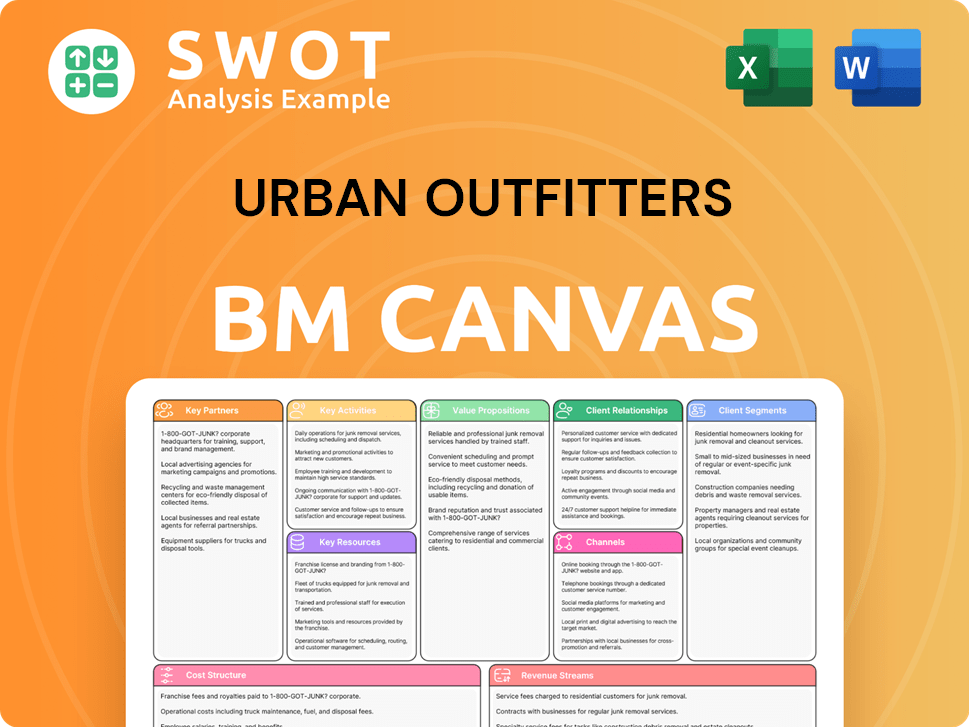
What Industry Trends Are Reshaping Urban Outfitters’s Competitive Landscape?
The retail industry, particularly for apparel and lifestyle brands, is undergoing significant shifts. These changes present both challenges and opportunities for companies like Urban Outfitters. Understanding the Urban Outfitters competitive landscape and the broader Urban Outfitters industry trends is crucial for strategic planning and sustained success.
Analyzing Urban Outfitters market analysis involves assessing its position relative to competitors, evaluating market dynamics, and anticipating future developments. This includes understanding consumer behavior, technological advancements, and the evolving demands of the fashion retail market.
E-commerce and digital engagement are accelerating, requiring continuous investment in technology and digital marketing. Sustainability and ethical practices are increasingly important to consumers, influencing brand choices. The rise of social commerce and personalized shopping experiences is reshaping how consumers discover and purchase products.
Intense competition from both established and emerging direct-to-consumer brands poses a significant challenge. Economic uncertainties, such as inflation, can affect consumer spending on discretionary items. Supply chain disruptions and the fast pace of fashion trends require constant adaptation and innovation. Owners & Shareholders of Urban Outfitters should be aware of these risks.
Expansion into emerging international markets, particularly in Asia, offers potential for revenue growth. Diversification of the brand portfolio or strategic acquisitions in complementary sectors could strengthen market position. The growth of the rental economy, as seen with Nuuly, provides opportunities beyond traditional retail.
Leveraging brand strength, embracing technological advancements, and adapting to changing consumer values are key. Focus on sustainable practices and transparent supply chains to meet consumer expectations. Strategic investments in digital marketing and e-commerce infrastructure are essential for maintaining competitiveness.
To thrive in the evolving retail landscape, Urban Outfitters must focus on several key strategies. These include enhancing its e-commerce capabilities, expanding into new markets, and embracing sustainability. Addressing supply chain challenges and adapting to fast-changing fashion trends are also crucial.
- Invest in personalized shopping experiences and AI-driven recommendations to boost online sales.
- Explore expansion into Asian markets to capitalize on growth opportunities.
- Integrate sustainable practices throughout the supply chain to meet consumer demand.
- Diversify product offerings and consider strategic acquisitions to broaden its market reach.
Urban Outfitters Porter's Five Forces Analysis
- Covers All 5 Competitive Forces in Detail
- Structured for Consultants, Students, and Founders
- 100% Editable in Microsoft Word & Excel
- Instant Digital Download – Use Immediately
- Compatible with Mac & PC – Fully Unlocked
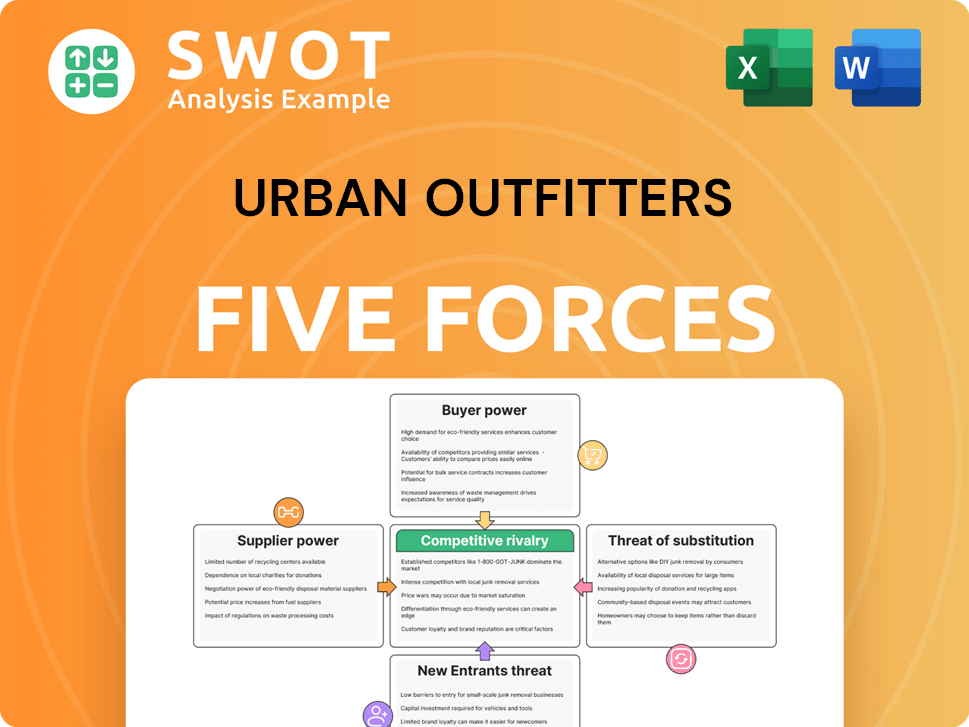
Related Blogs
- What are Mission Vision & Core Values of Urban Outfitters Company?
- What is Growth Strategy and Future Prospects of Urban Outfitters Company?
- How Does Urban Outfitters Company Work?
- What is Sales and Marketing Strategy of Urban Outfitters Company?
- What is Brief History of Urban Outfitters Company?
- Who Owns Urban Outfitters Company?
- What is Customer Demographics and Target Market of Urban Outfitters Company?
Disclaimer
All information, articles, and product details provided on this website are for general informational and educational purposes only. We do not claim any ownership over, nor do we intend to infringe upon, any trademarks, copyrights, logos, brand names, or other intellectual property mentioned or depicted on this site. Such intellectual property remains the property of its respective owners, and any references here are made solely for identification or informational purposes, without implying any affiliation, endorsement, or partnership.
We make no representations or warranties, express or implied, regarding the accuracy, completeness, or suitability of any content or products presented. Nothing on this website should be construed as legal, tax, investment, financial, medical, or other professional advice. In addition, no part of this site—including articles or product references—constitutes a solicitation, recommendation, endorsement, advertisement, or offer to buy or sell any securities, franchises, or other financial instruments, particularly in jurisdictions where such activity would be unlawful.
All content is of a general nature and may not address the specific circumstances of any individual or entity. It is not a substitute for professional advice or services. Any actions you take based on the information provided here are strictly at your own risk. You accept full responsibility for any decisions or outcomes arising from your use of this website and agree to release us from any liability in connection with your use of, or reliance upon, the content or products found herein.